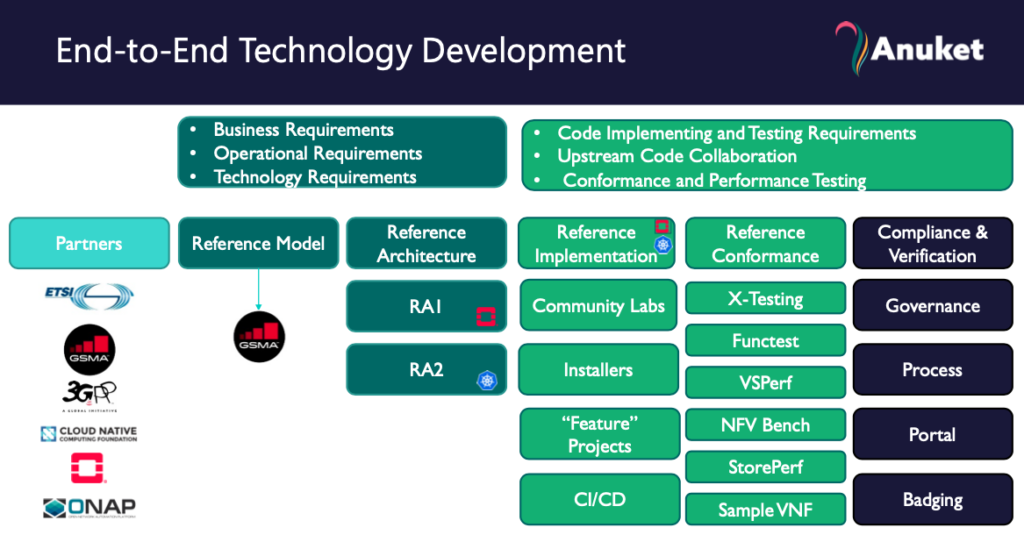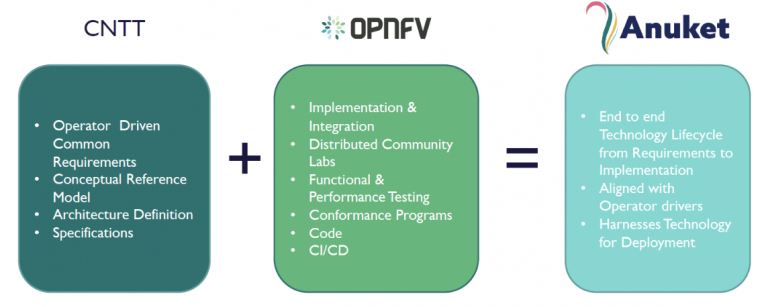By: Walter Kozlowski, Anuket TSC Co-Chair (Former)
Lakelse, the latest version of Anuket was released to the public on January 4, 2022!
Anuket Overview
Anuket is an LF Networking project launched just a year ago out of a merger of CNTT (Cloud iNfrastructure Telco Taskforce) with OPNFV (Open Platform for Network Functions Virtualization). The newly minted Anuket team not only successfully established the project but also delivered two full releases in its first year – quite an accomplishment! The Lakelse release builds on Kali, the first Anuket full release delivered June 2021. Another item of note is that the Reference Model component was recently published as a GSMA permanent reference document NG.126 v.2.0, and Reference Architecture 1 (OpenStack based) as NG.133.
Anuket occupies a unique position in the telco industry because it includes operator requirements collection and normalization, open source software development, through to an industry verification program for ecosystem implementations, all under a single initiative. The Anuket community, constituting subject matter expert representatives from telco operators and their technology suppliers are very cognizant to the “real world” challenges of the industry. The Anuket community prioritizes outreach to the wider community, initializing or strengthening Anuket’s relationship with other LFN projects as well as with several industry organizations like GSMA, ETSI, CNCF, Open Infrastructure Foundation, O-RAN Alliance, ITU among others.
 Anuket Lakelse
Anuket Lakelse
So, what specifically have we achieved in Lakelse?
Numerous Anuket projects and work streams continued their efforts to strengthen container-based open infrastructure specifications and implementations – an area that is increasingly important to the telco industry. Some of the efforts include:
- ViNePerf has significantly enhanced its network performance testing framework to support Kubernetes use cases resulting in the Globecom 2021 Conference Paper, “Benchmarking Kubernetes Container-Networking for Telco Usecases”
- Barometer improved automation, enabling easier testing and configuration of the metrics collection
- CIRV added 12 Kubernetes post-deployment validations
- And finally, a new project Thoth to investigate using AI/ML methods for some NFV use cases starting from failure prediction.
On the requirements side
Both RA1 and RA2 follow the Reference Model (RM) efforts in evolving open cloud infrastructure specification to include Hybrid, Multi-Cloud model, with significant updates to interaction models, security, and life cycle requirements. Security for such models has been and will continue to be subject of a very intense discussion in the telco industry. Security starts at the infrastructure level, so there is a growing interest in Anuket outcomes and more collaboration. One effort in this area: GSMA Fraud and Security Group (FASG) work on 5G security references the Anuket Reference Model, and the collaboration with FASG is growing.
Hybrid, Multi-Cloud model and AI/ML utilisation, will be in my view a major theme of Anuket work in the upcoming releases, reflecting a growing global interest in more sophisticated operating models for telecommunication operators facing the challenges of real-life 5G/Edge/IoT implementations.
Anuket Assured
The Lakelse release coincides with the official launch of the Anuket Assured verification program. Announced at ONE Summit last year, the program is now officially welcoming industry participants with program documentation and a participation form published on the LFN website. The program is an open source, community-led compliance and verification program that allows companies to demonstrate the readiness and availability of commercial cloud native and virtualized products and services, including NFVI, Cloud Native Infrastructure, VNFs, and CNFs, using Anuket and ONAP components.
Leadership
Anuket members, per its new Charter, elected the 2022 Technology Steering Committee and Co-chairs: Beth Cohen and Gergely Csatari. On behalf of outgoing 2021 TSC Co-chairs, Al Morton and myself, we would like to thank all Anuket contributors for their fantastic efforts in 2021 and wish the new TSC and the new Co-chairs all the best in their 2022 work! We also welcome our fist cohort of Anuket Ambassadors around the globe to help represent the project and onboard new participants.
Collaboration
This week the Anuket community will be active participants in the LFN Developer & Testing Forum virtual event with 11 topic proposals. The event is free of charge and we encourage you to register today!
 As the Anuket Project’s first release, Kali benefits from the combined expertise and contributions from the two organizations that merged early this year: the Open Platform for NFV (OPNFV) open source project in LFN and the Cloud iNfrastructure Telco Task Force (CNTT). Many work streams developing Reference specifications and projects developing implementations, testing utilities, telemetry collection and management, and other capabilities comprise the Kali Release.
As the Anuket Project’s first release, Kali benefits from the combined expertise and contributions from the two organizations that merged early this year: the Open Platform for NFV (OPNFV) open source project in LFN and the Cloud iNfrastructure Telco Task Force (CNTT). Many work streams developing Reference specifications and projects developing implementations, testing utilities, telemetry collection and management, and other capabilities comprise the Kali Release.